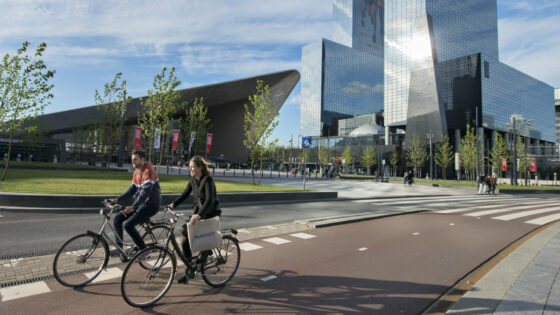
Rotterdam, in the Netherlands, is one of the cities now promoting cycling as a means of transport and leisure. The city is an example at European level, alongside Amsterdam of course. The aim of the municipality is above all to create a more harmonious and pleasant city to live in, and that calls for softer means of transport, starting with the bicycle.
Historically less bicycle-friendly than Amsterdam, Rotterdam began its transformation in the early 2000s with the development of an extensive network of bicycle paths. On the other hand, the time that the traffic light turns green has been deliberately extended to improve the flow of traffic for cyclists and pedestrians. Logically, the number of cyclists has continued to grow since then. Currently, 28% of city trips are made by bicycle, which is within the national average. The city’s goal is to increase this statistic to 32% by 2030 and 34% by 2040.
To achieve this, it tends to develop large green spaces, where it is pleasant to walk and cycle. As for the future development of new cycle paths, it will adopt different formats in terms of permitted speeds and width, to meet the needs of all types of cyclists and cyclists in traffic.
Over time, many developments in the city center have also been made, such as the rehabilitation of the main traffic axis and the construction of numerous parking spaces for bicycles. In the past 20 years, 6,500 new places have been created. Seven new parking projects are also under construction. Finally, to get the population used to cycling, cycling lessons are being given in schools and in various neighbourhoods.
It should be noted that the investment in active mobility contributes to the fact that the inhabitants of the city receive cleaner air and much less noise and air pollution. A very first festival dedicated to cycling, Rotterdam Rides, even took place in the city on May 22, 2022.
At the regional level, bicycle highways will also be built to develop the practice of cycling over longer distances. This new cycling network must be divided into four levels: regional, urban, local and recreational.
(ETX Daily Up)